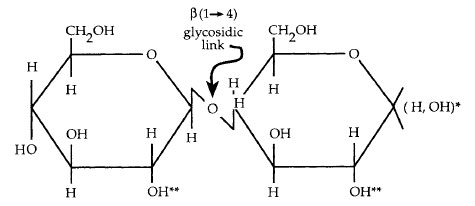Carbohydrates
Pure carbohydrates have the empirical formula (CH2O)n. The smallest carbohydrates are simple sugars, or monosaccharides. Glucose is the sixcarbon monosaccharide (hexose) used as a basic source of energy by most heterotrophic cells. Ribose and deoxyribose are the five-carbon sugars (pentoses) that serve a structural role in the nucleic acids RNA and DNA , respectively. Oligosaccharides are small polymers of two to six monosaccharides. Sucrose is a disaccharide of the two monosaccharides glucose and fructose (an isomer of glucose). Sucrose is the major sugar transported between plant cells, whereas glucose is the primary sugar transported between animal cells. Lactose, the major sugar in milk, is a disaccharide of glucose and galactose (an epimer of glucose). Most of the carbohydrate molecules in nature are composed of hundreds of sugar units and are referred to as polysaccharides.
The monomers of polysaccharides become covalently connected by glycosidic bonds (Figure 2-1).
 |
| Figure 2-1 Cellobiose, the basic repeating unit of cellulose, is a disaccharide of glucose molecules joined by b(1→4) glycosidic linkages. |
Carbohydrates serve several major functions in living systems. Monosaccharides and oligosaccharides serve as readily utilizable energy sources. Starch and glycogen act as macromolecular energy stores in plants and animals, respectively. Carbohydrates perform structural roles, such as cellulose in plant cell walls and chitin in the exoskeletons of arthropods. Surface carbohydrates are often complexed with proteins as glycoproteins or with lipids as glycolipids in the plasma membrane. The great potential for structural diversity and thus, specificity, makes these molecules very useful as cell-recognition markers in cellular communication and in cell-to-cell attachments.
Notes
Glycogen consists of polymers of glucose units joined by α(1→4) linkages and forms branched chains by α(1→6) linkages. Starch has fewer α(1→6) linkages than glycogen.




